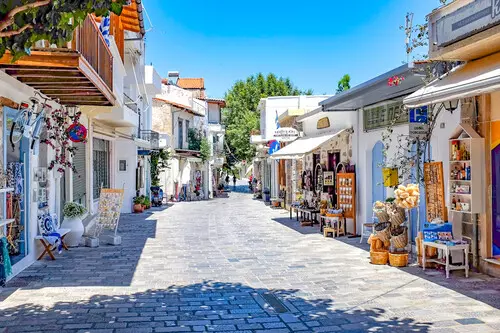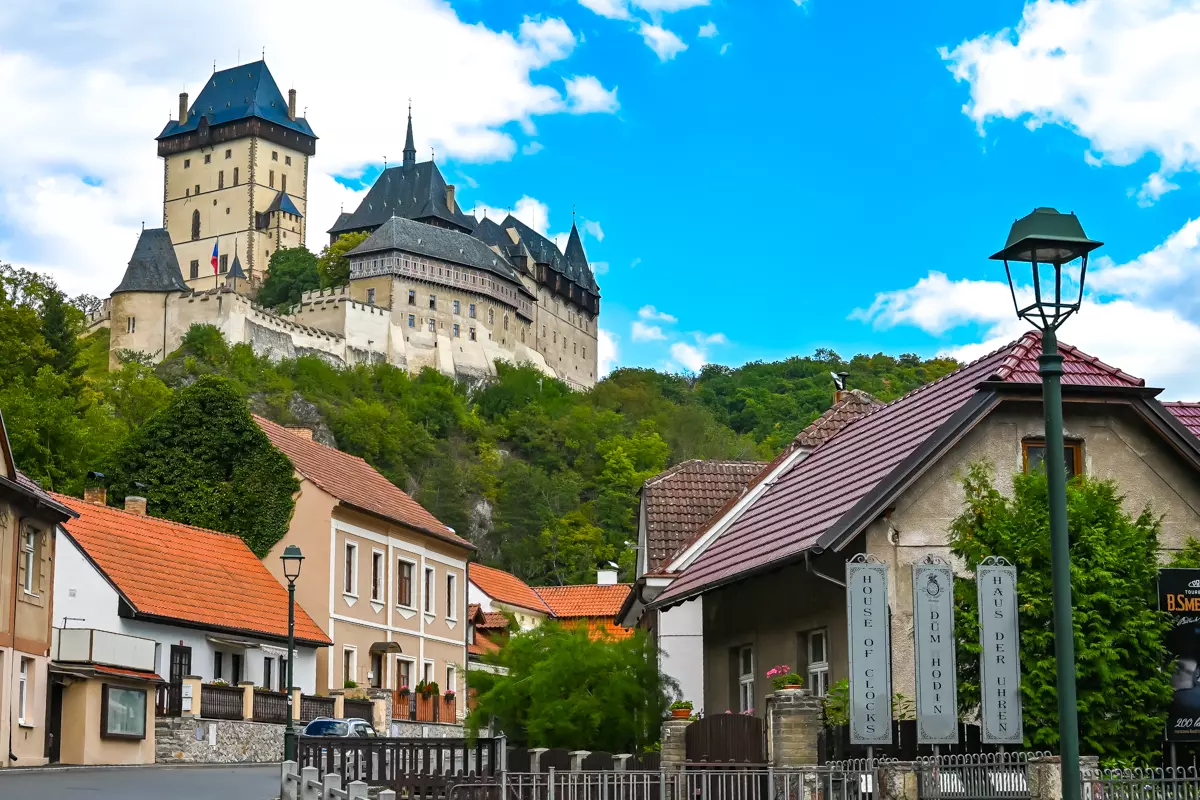What To See & Do In Prague: My Favorite Spots
Prague is a truly special city, and I honestly think it’s impossible not to fall in love with it. History surrounds you at every turn, with centuries-old buildings that never stop catching your eye. Every cobblestone street reveals something new and surprising. The castle, museums, galleries, and churches all invite you to dive into the city’s rich history, culture, and traditions.
If you love art and architecture, you might lose count of the Gothic and Baroque buildings here — there are so many, each more impressive than the last! And then there’s the Vltava River, flowing peacefully beneath the city’s ancient bridges, adding even more charm. So, what to see in Prague? Keep reading, and I’ll share the must-visit places to make the most of your time in this magnificent city.

What To See In Prague
Prague Castle

Perched on a hill along the left bank of the Vltava River, Prague Castle is one of the largest ancient castles in the world. With a history spanning nearly a thousand years, it’s often seen as the heart of where Prague’s story began. Today, Prague Castle is not only the official residence of the president but also a proud UNESCO World Heritage Site.
But it’s not just the castle itself that draws visitors in. The entire complex is full of treasures — from the magnificent St. Vitus Cathedral and St. George’s Basilica to Golden Lane, the Old Royal Palace, and more. Walking through these grounds truly feels like stepping back in time. And if you love nature as much as history, the royal gardens are the perfect place to slow down and soak up the atmosphere.
Practical Information: The Prague Castle complex is open daily from 6 a.m. to 10 p.m., while the interior exhibits (St. Vitus Cathedral, Old Palace, etc.) can be visited from 9 a.m. to 5 p.m. While entry to the castle courtyard is free, a ticket is required to explore the castle itself and other buildings within the complex. Ticket prices vary depending on what you choose to visit, but regardless, it’s definitely worth seeing as much as possible.
Charles Bridge

The Charles Bridge definitely deserves a top spot among the most beautiful bridges in the world. Built between 1357 and the early 15th century, this majestic structure connects both banks of the Vltava River and has been a symbol of Prague for centuries. What makes it even more striking are the sculptures of saints lining both sides — around thirty in total, each with its own story from Czech religion and history.
The bridge is always alive with energy. It’s not just the steady stream of visitors, but also the street musicians, painters, and craft sellers who bring it to life. Personally, I think the Charles Bridge is at its most magical after dark, when the lights make the stone glow and the whole place feels like a scene from a fairytale. For me, it’s absolutely one of the best things to see in Prague!
Accommodation: Here are all your hotel options in Prague.
Prague Astronomical Clock

Prague is home to one of the oldest astronomical clocks in the world — and the oldest still in operation. First installed back in 1410, it has stopped ticking more than once over the centuries, but each time it was carefully restored to working order.
Today, the Prague Astronomical Clock is more than just a timepiece. Besides showing the hour and date, it also tracks the positions of the Moon and Sun, zodiac signs, holidays, and more. The real highlight, though, is the hourly show. Every day between 9 a.m. and 9 p.m., 12 figures of the apostles appear through little doors above the clock face, drawing big crowds to the Old Town Square.
So, be sure to time your visit carefully, or you might have to wait another hour for their appearance. The history of this ancient clock is also shrouded in legends, one of which suggests that the clockmaker was blinded to ensure no other city could replicate such a masterpiece.
Wenceslas Square

Wenceslas Square is not just one of the largest squares in Prague — it’s also one of the most important. Located in the New Town, it stretches for about 750 meters, more like a wide boulevard than a traditional square. About 600 years ago, this space was a bustling horse market, but over the centuries it has transformed into the heart of many historic rallies and events that shaped the nation.
Today, Wenceslas Square is still very much alive. It hosts demonstrations, celebrations, and everyday city life. Walking here, you’ll find a lively mix of shops, cafes, restaurants, bars, and hotels, all surrounded by beautiful historical buildings. At the top of the square stands the impressive statue of St. Wenceslas. The National Museum rises just behind it, making the whole place feel alive with both history and the buzz of the city.
Clementinum

The Clementinum is a massive complex of historic buildings dating back to 1653, and it’s definitely one of those places you don’t want to miss. Its biggest gem — and one of Prague’s true highlights — is the breathtaking Baroque library. Step inside, and you’ll be amazed by the details: gilded decorations, painted ceiling frescoes, and antique globes that look more like works of art than instruments.
Another favorite spot is the 17th-century Astronomy Tower. Once used for astronomical observations, it now draws visitors with its fascinating clock mechanism and the terrace’s unforgettable panoramic views. Climbing to the top is well worth it for the chance to see Prague spread out beneath you in all its beauty.
Opening Times: opening hours may vary slightly depending on the season, the Clementinum is generally open from 10 a.m. to 6 p.m.
Museum of Communism

Prague is full of fascinating museums, but the Museum of Communism in the city center really stands out. A visit here feels like stepping straight into the communist era, with exhibits that dive deep into the politics, propaganda, and everyday life of Czechoslovakia from 1948 to 1989.
The walls are covered with bold propaganda posters, and the rooms are filled with artifacts like uniforms, statues, photographs, films, and even audio recordings from the time. What I found especially striking were the immersive reconstructions. There was an interrogation room, a classroom, and even a factory workspace. Each one gives you a powerful sense of what daily life was like under communist rule.
Tip: You can buy tickets to the Museum of Communism in advance online here.
St. Vitus Cathedral

St. Vitus Cathedral is one of Prague’s most impressive landmarks — a Gothic masterpiece that took nearly six centuries to complete. Construction began in 1344 and wasn’t finished until 1929, which is why you’ll also notice Renaissance and Baroque details alongside its Gothic design. For centuries, this cathedral has been at the heart of Czech history, hosting not only religious services but also the coronation ceremonies of kings and queens.
Part of the Prague Castle complex, the cathedral is striking from the outside with its sculptures and stained-glass windows. Inside, soaring vaults and high arches make the space feel both grand and sacred.
What struck me most were the stained-glass windows. Each one tells a story from Czech history or the Bible, and they fill the cathedral with vibrant color.
Inside, you’ll also find the enormous 16-ton bell and the St. Wenceslas Chapel, where the tombs of St. Wenceslas, Charles IV, and other royals rest. For a real highlight, climb the nearly 100-meter tower. From the observation deck, you can see some of the best panoramic views over Prague.
Opening Hours: during the warm season (April to October), the cathedral is open for visitors from 9 a.m. to 5 p.m. In the cold season (November to March), visiting hours are from 9 a.m. to 4 p.m. The cathedral may be closed to visitors during public holidays or religious ceremonies.
Discover: See availability for a tour of Prague Castle (includes a visit to St. Vitus Cathedral!)
Czech Beer Museum
The Czech Republic is famous for its love of beer — in fact, it has the highest beer consumption per capita in the world. So it makes perfect sense that Prague is home to the Czech Beer Museum. Exploring its 13th-century cellars while learning about the history and culture of beer is a fascinating experience. You’ll get to see how beer has been brewed over the centuries and, of course, sample a variety of flavors along the way.
The guided tour takes about 90 minutes. The experience starts with a look at the global history of beer and continues with hundreds of historical exhibits. A fun touch comes at the end — the chance to design and put a personalized label on your very own beer bottle.
Vltava River

If you’ve ever seen a photo of Prague, chances are you’ve noticed the bridges stretching across the Vltava River. This river is truly one of the city’s gems — not only does it make the skyline even more beautiful, but it also offers plenty of ways to enjoy Prague from the water.
Cruises on the Vltava are a great way to see the city from a different perspective. Whether you’re after a romantic evening, a dinner cruise, or just a short sightseeing ride, there are lots of options to choose from. Some even include panoramic tours on open glass boats.
Most cruises are very affordable too, usually costing no more than around 20 euros per person if meals aren’t included. It’s an easy and memorable way to add something special to your stay in Prague.
Church of Our Lady before Tyn

The Church of Our Lady before Týn is one of the most recognizable landmarks on Prague’s skyline, with its dramatic twin towers rising about 80 meters high. Each tower is topped with eight smaller spires, giving the church a fairytale-like appearance that dominates Old Town Square. This Gothic masterpiece has been part of the city’s heart since the 14th century.
Step inside, and you’ll find a richly decorated Baroque interior added in the 17th century. The grand altar immediately catches your eye with its image of the Madonna and Child, radiating elegance.
The church also has some fascinating historical treasures: the oldest organ in Prague and the tomb of the famous astronomer Tycho Brahe. It’s a place where history, art, and science meet under one roof — and definitely worth a visit while exploring the Old Town.
Please note: the church is closed on Mondays. On Sundays, it is open from 10 a.m. to 12 p.m., and on other days, it is open from 10 a.m. to 12 p.m. and again from 3 p.m. to 5 p.m.
Discover: Tyn Church classical music concert.
The Prague National Museum

The National Museum, standing proudly at the top of Wenceslas Square, is the largest museum in the Czech Republic.
Inside, the museum holds more than 14 million exhibits, so you could easily spend hours wandering its halls. My favorite part was the history and nature sections — from prehistoric fossils to archaeological treasures, it felt like traveling through time. There are also fascinating displays on theater, social sciences, and even artifacts from Asia, Africa, and the Americas, which I didn’t expect to find in Prague.
The National Museum also oversees several other institutions, including the Czech Museum of Music and the National Museum Library. To make the experience even richer, it regularly hosts cultural and educational programs that are engaging for both adults and children. Whether you’re a history buff or just looking for a rainy-day activity, this museum is an excellent stop on your Prague itinerary.
Tip: You can buy a combined ticket to the National Museum by clicking on this link.
Prague Jewish Quarter

The Jewish Quarter is one of Prague’s most historic districts, filled with synagogues, old residential houses, and landmarks that reflect the city’s rich Jewish heritage.
Explore the Jewish Museum to learn about the community’s long history and daily life, including the difficult years of the occupation. Inside, the museum’s exhibitions showcase ancient manuscripts, clothing, religious artifacts, and personal stories that make the past feel alive.
Of course, don’t miss the Old Jewish Cemetery. The oldest of its kind in Europe, it offers a unique and moving glimpse into centuries of Jewish history in Prague.
Also read: Things to Do in Prague Jewish Quarter
Prague Zoo

If you’re traveling to Prague with kids, a day at the zoo is honestly one of the best things you can do as a family. I wasn’t sure what to expect before visiting, but Prague Zoo really surprised me. It’s huge, beautifully designed, and feels more like a nature park than a typical zoo.
Opened back in 1931, it’s one of the oldest zoos in Europe and is about to celebrate its 100th anniversary. Today it stretches across 60 hectares and is home to more than 5,000 animals. It’s cleverly divided into themed pavilions that recreate natural habitats, so exploring feels a bit like traveling the world. Highlights include the Indonesian jungle, gorilla and elephant enclosures, the hippo pavilion, aquariums, and the Southeast Asia exhibit.
What makes Prague Zoo special for me is that it’s not only fun but also meaningful. The zoo has a strong focus on conservation and has successfully bred endangered species, including the rare Przewalski’s horses. Seeing them in real life was a highlight.
Tip and Opening hours: I recommend buying tickets online in advance to avoid long lines at the ticket office and to pay a little less. Wear comfortable clothes and shoes, as you’ll be walking a lot on uneven paths with some inclines and declines. The zoo is open from 9 a.m. to 5 p.m. from May to August, but hours are shorter in other months. Be sure to check the official website for the exact opening times before your visit.
National Gallery Prague
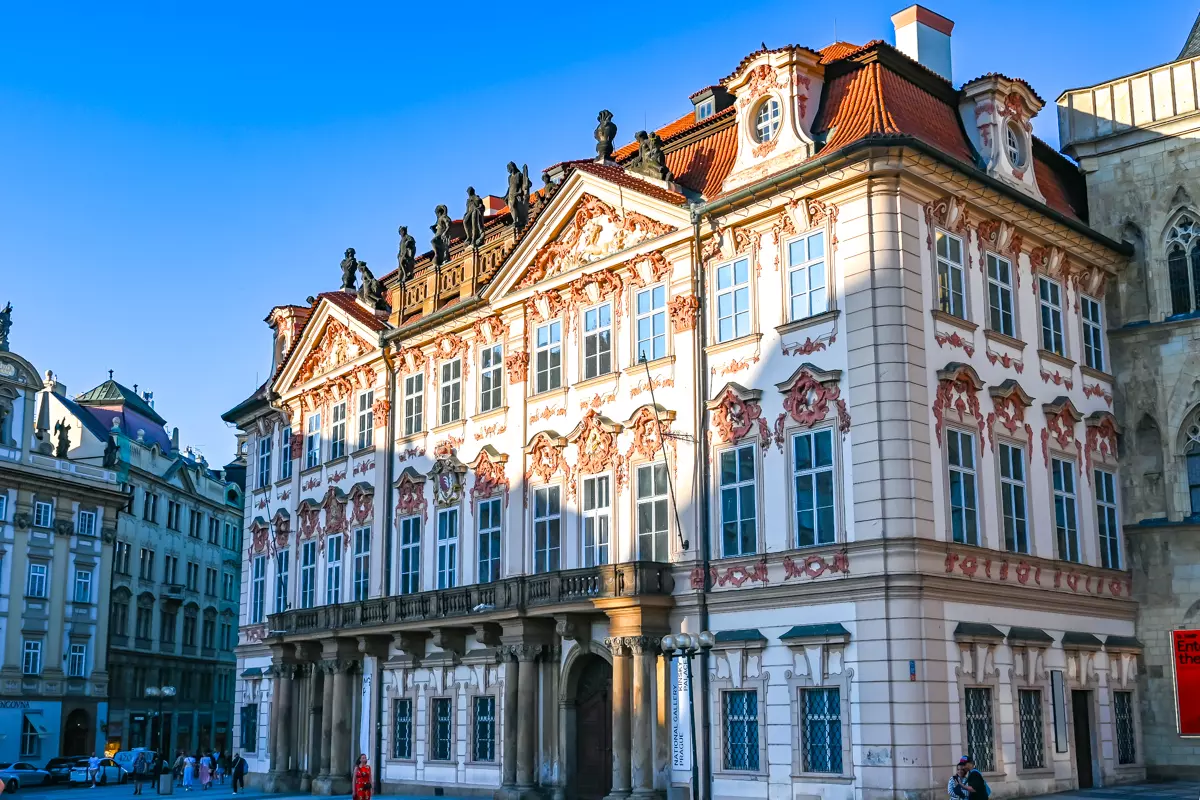
Founded in 1949, the National Gallery in Prague is spread across several historic buildings, including St. George’s Monastery, Kinsky Palace, Sternberg Palace, and the Trade Fair Palace. Together, these spaces present exhibitions that cover centuries of art history — from the Middle Ages to contemporary works. Each building focuses on a specific period or theme, making it easy to dive into the era that interests you most.
The collections feature thousands of pieces, including paintings, sculptures, decorative art, and more. Highlights range from old masters to modern and Asian art, ensuring there’s something for every art lover to enjoy.
Working Hours: The National Gallery is typically open from 10 a.m. to 6 p.m., but hours may vary depending on the specific location. It’s advisable to check the official website for the most up-to-date information when planning your visit.
Strahov Monastery

The Strahov Monastery was founded in 1140 and truly came to life a few years later, in 1143, when a group of monks settled here. Today, it’s one of the city’s most beautiful historic sites to explore. Highlights include the Church of Saint Roch, the Basilica of the Assumption of the Virgin Mary, and above all, its famous library — one of the oldest and most important in Europe.
This 800-year-old library holds more than 200,000 volumes, but what really captures visitors is not just the collection itself, but the breathtaking Baroque interiors. The two main halls — Theology and Philosophy — are decorated with stunning ceiling frescoes that make you stop in awe.
The monastery is also home to the Strahov Gallery, where you can see a wide range of artworks, from religious icons to historical paintings. It’s a peaceful yet inspiring place that combines history, culture, and art all in one visit.
Accommodation: Here are all your hotel options in Prague.
The National Theatre In Prague
The National Theatre is one of Prague’s most important cultural landmarks and a true symbol of Czech national pride. It hosts drama, opera, and ballet performances, continuing a tradition that dates back to the 19th century. At that time, most cultural life in Prague was conducted in German, so the idea of a national theater became central to preserving and promoting the Czech language. Construction began in 1868, and the first performance was staged in 1881.
I’d recommend not only attending a performance if you can, but also joining a guided tour. It’s a great way to learn more about the theatre’s history and architecture, admire the lavish interiors, and even peek behind the scenes.
St. Nicholas Church
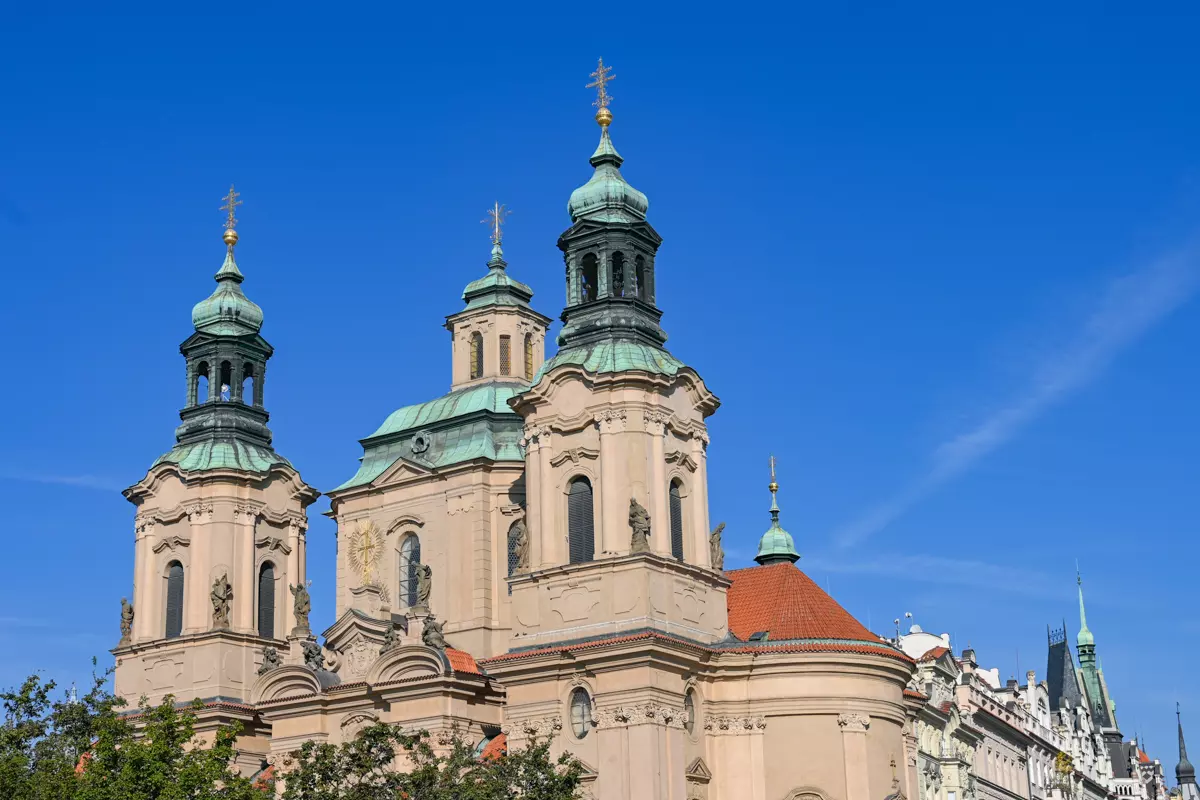
Right on Old Town Square stands St. Nicholas Church, one of the most beautiful Baroque landmarks in Prague. The exterior is already impressive, but stepping inside is where the real surprise awaits.
The richly decorated interior, with its massive dome and ceiling frescoes, makes you want to stop and look up for a while. The way the light plays on the marble, gold details, and ornate designs creates a truly magical atmosphere.
One of the highlights is the enormous chandelier that dominates the space, but music lovers will especially appreciate the church’s historic organ — famously played by Mozart himself.
Also read: Guide to Old Town Square in Prague
Dancing House

One of Prague’s quirkiest landmarks is the Dancing House — an unusual building whose curves make it look like a pair of dancers frozen mid-move. You can’t miss it while exploring the city center, and it’s definitely worth a stop, not just for the architecture but also for what’s inside.
The building houses an art gallery spread across three floors, with exhibitions ranging from paintings and photography to textiles and furniture. The gallery also hosts lectures, discussions, and creative workshops, so there’s always something new going on.
For me, the highlight is the Glass Bar on the rooftop. It’s the perfect spot to grab a drink, relax, and take in panoramic views of Prague from above. Even if you’re not a big architecture fan, the combination of art, atmosphere, and city views makes the Dancing House a fun addition to your Prague itinerary.
Lennon Wall

The Lennon Wall is one of the most colorful and symbolic places in Prague — and honestly, it’s hard not to stop here for a while. Dedicated to John Lennon, it became a gathering point after his death in 1980, when fans began leaving flowers, painting portraits, and writing lyrics from his songs. Over the years, the wall turned into a space filled with messages of peace, love, and freedom.
Back in the communist era, authorities would often paint over it to suppress free expression, but each time, artists came back and covered it again. That persistence transformed the wall into a powerful symbol of hope and protest.
Today, the Lennon Wall is constantly changing. I loved wandering around it, reading the messages, spotting little drawings tucked between layers of graffiti, and even adding my own tiny note.
Discover: Fat tire electric bike guided tour.
Statue Of King Wenceslas Riding An Upside-Down Dead Horse

Just off Wenceslas Square, inside the Lucerna Palace arcade, stands one of Prague’s quirkiest works of art. Created by the well-known Czech sculptor David Černý, this unusual piece shows St. Wenceslas not sitting proudly on his horse, as in the famous statue on the square, but instead mounted on the belly of an upside-down, dead horse.
The sculpture is meant as a parody of the traditional monument and reflects Černý’s eccentric style, which often mixes humor, provocation, and social commentary. Even if you’re not into modern art, it’s worth a quick stop. It is one of the strangest and most memorable sights in Prague.
Vyšehrad
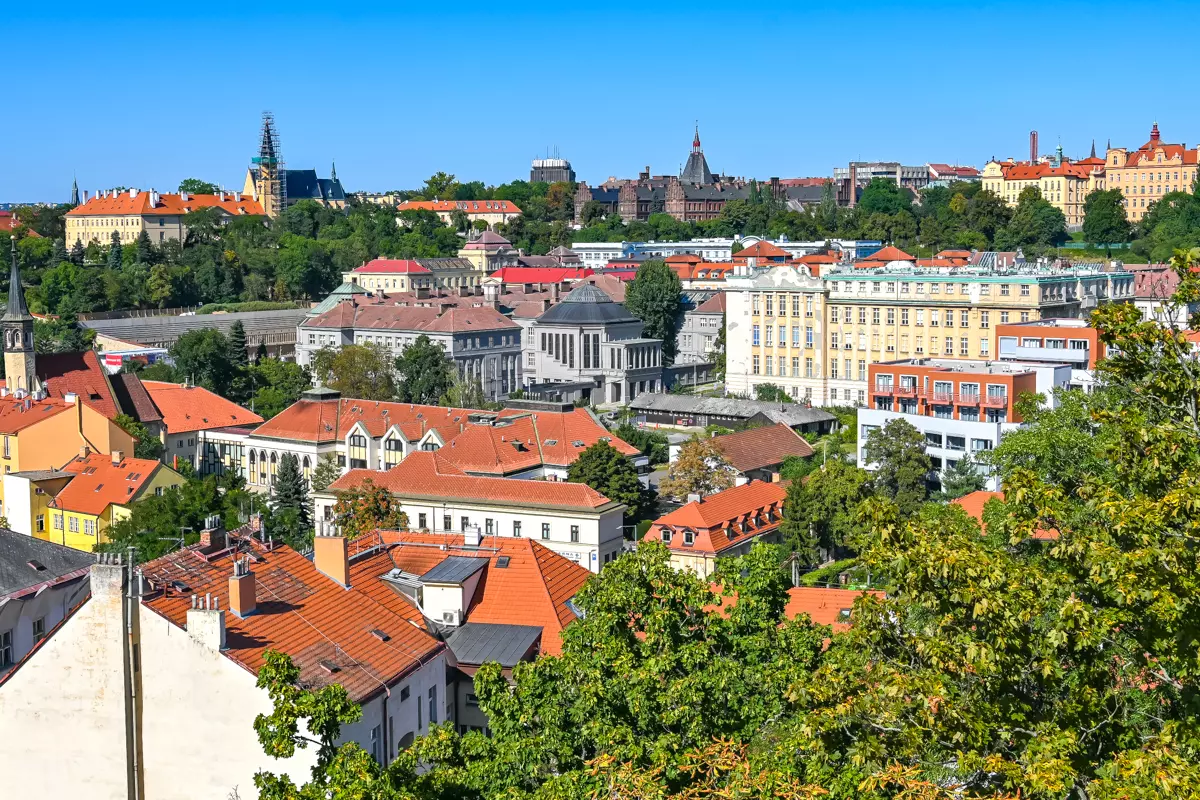
If you’re looking for a historic spot with stunning views of Prague, Vyšehrad is a must-visit. This ancient fortress, perched on a hill above the Vltava River, dates back to the 10th century and offers a peaceful escape from the bustling city below. Walking along its old walls, you can enjoy panoramic views of Prague’s skyline, the river, and the iconic bridges.
Highlights include the impressive Basilica of St. Peter and St. Paul, the Vyšehrad Cemetery, where many famous Czech personalities are buried, and the striking neo-Gothic gates. For me, strolling through Vyšehrad felt like stepping back in time, enjoying the calm atmosphere while the city buzzed gently below.
Memorial To The Victims Of Communism

The Memorial to the Victims of Communism is one of Prague’s most powerful monuments. It commemorates those who suffered under the communist regime in the former Czechoslovakia. Unveiled in 2002 at the base of Petřín Hill, the memorial has since become an important reminder of this dark chapter in history.
The memorial features a series of bronze statues placed on a staircase. The first figures appear whole and healthy, but as you move upward, each statue becomes more fragmented and decayed — some are missing limbs, others are visibly worn away. This progression symbolizes the suffering, both physical and spiritual, endured by countless people during the regime.
How To Get To Prague
Prague is well connected to the rest of the world, and getting here is easier than you might expect. Václav Havel Airport is the main international gateway and one of the busiest airports in Central Europe, serving around 14 million passengers every year.
Major international airlines like Lufthansa, Turkish Airlines, British Airways, Emirates, Delta, and Korean Air all operate flights here, while low-cost carriers such as Ryanair and Wizz Air make it easy to find budget-friendly options from across Europe. Once you land, the airport is only about 30 minutes from the city center, so you’ll be exploring Prague in no time.
Weather In Prague
Prague has a moderate climate with warm summers and cold winters, influenced by both continental and Atlantic weather patterns. Spring usually begins to feel mild by May, with average temperatures around 15–17°C in June. July and August are the warmest months, averaging about 19°C, with mostly dry days but the occasional summer shower.
Winters, on the other hand, are chilly but not extreme. The average temperature drops to around –1°C, and while snow isn’t guaranteed, the city’s historic streets and rooftops look especially magical when dusted with a light layer of snow.
I’ve visited Prague twice — once at the end of summer and once in late September — and both times the weather was fantastic. Warm, sunny days made it easy to spend hours wandering the streets and squares. In September, I noticed there were also fewer tourists compared to the peak of summer, which made exploring even more enjoyable. For me, this time of year was perfect for soaking in the city’s atmosphere at a relaxed pace.
Average Temperature
Where To Eat In Prague

Prague is famous for its dumplings, goulash, and Pilsner beer, but the city has so much more to offer when it comes to food. You’ll find everything from traditional Czech dishes to modern takes – in cozy family-run pubs as well as stylish cafes.
Lokál Dlouhááá
Near Old Town, Lokál Dlouhááá serves fresh, unpasteurized Pilsner and traditional Czech dishes like svíčková and goulash. With a lively atmosphere and locally sourced ingredients, it’s a popular spot for hearty meals and perfectly poured beer. It’s a great place to experience authentic Czech food and enjoy the buzz of a busy local favorite.
U Modré Kachničky
Step into U Modré Kachničky for a classic Czech dining experience in a historic setting. With specialties like roasted duck and game dishes, this cozy restaurant captures traditional Czech flavors in a warm and welcoming atmosphere.
Mlýnec
For a more contemporary Czech dining experience, Mlýnec is a great choice. Located near Charles Bridge, the restaurant offers creative takes on traditional dishes, using fresh, seasonal ingredients. With its modern interior and views of the Vltava River, it’s perfect for a relaxed lunch or dinner after sightseeing.
Mlejnice
Locals love Mlejnice for its rustic, friendly vibe and generous portions. It’s the perfect place to enjoy hearty comfort food like goulash or pork knuckle without any fuss.
Places To Stay In Prague
Prague offers a wide range of hotels to suit every taste and budget, from luxurious five-star options to simple one-star accommodations. If you want to be close to historical and cultural landmarks, you can stay in the Old Town or Lesser Town.
For those who enjoy entertainment and nightlife, the New Town or Žižkov district would be ideal. If you prefer nature and peace, Hradčany or Vyšehrad are excellent choices.
Below, I’ve listed several hotels across different areas of the city and within various price ranges, so I hope this helps you find the best option for your visit to Prague.
Budget Hotels
- Residence Tabor – economy-class hotel located in the Žižkov district, offering convenient access to the city’s main attractions. The rooms are equipped with air conditioning, balconies, TVs, and private bathrooms.
- A1 Royal Plaza: well-rated 3-star hotel, ideally located in the heart of Prague. The rooms are simply furnished and feature flat-screen TVs, coffee makers, and private bathrooms.
Mid-Range Hotels
- Iris Hotel Eden located on the outskirts of the center of Prague, offering easy access to the city’s heart via public transport. The spacious and tastefully furnished rooms come with air conditioning, flat-screen TVs with satellite channels, soundproof walls, and private bathrooms.
- Pytloun Old Armoury Hotel Prague, Stará Zbrojnice– situated in a 17th-century building by the Vltava River, this hotel is just a 10-minute walk from Charles Bridge and the National Theater. The elegantly furnished rooms feature flat-screen TVs, minibars, safes, and private bathrooms.
INNSiDE by Meliá Prague Old Town – During my visit to Prague, I stayed at this stylish hotel, and it exceeded my expectations. The hotel is just a short walk from the Old Town, major attractions, restaurants, and charming streets, while still being quiet enough for a restful stay. The rooms are modern and comfortable, with thoughtful design, smart lighting, and large windows that fill the space with natural light. The hotel’s attentive staff and cozy common areas made my stay even more enjoyable.
Luxury Hotels
- The Mozart Prague – this hotel offers 70 rooms, each equipped with various amenities. The luxuriously decorated hotel offers lounges, a gym, three restaurants, and a spa and wellness center. Those seeking an extravagant and exclusive experience in the Old Town of Prague will definitely like this accommodation.
- Art Nouveau Palace Hotel located in a convenient location in Prague, so you can easily reach the Old Town. Guests are greeted with the highest-class rooms and a range of services, accompanied by warm hospitality. The luxuriously equipped rooms feature desks, flat-screen TVs, and private bathrooms.
How To Get Around Prague
There are numerous ways to get around Prague. For my trip, I chose not to rent a car and instead used public transportation.
The Prague metro is one of the fastest and most efficient ways to travel around the city. The metro system spans the city conveniently, allowing easy access to any destination in Prague. It has two lines and a total of sixty-one stops.
You can purchase metro tickets at stations and sometimes at certain hotels. Prices vary depending on whether you buy a one-time ticket or a ticket for several days.
You can also travel around Prague by bus and tram. For reaching more remote areas of Prague, buses are the best option. They run frequently, are affordable, and provide quick access to various destinations. Prague trams are slightly slower than buses and the metro. However, they remain popular with tourists and locals as a fun and affordable way to get around the city.
When it comes to taxis, I wouldn’t recommend using the traditional ones, as they can be overpriced. Instead, ride-hailing apps like Bolt or Uber are reliable and much cheaper. Personally, I used Bolt for most of my journeys around Prague. It was super convenient — quick, affordable, and easy to use even late in the evening.
Please note: a public transport ticket in Prague is valid for use on the metro, buses, and trams for the duration of its validity. After purchasing your ticket, activate it by inserting it into a ticket validator (composter) at the metro entrance or upon entering a bus or tram.
Prague Tours & Activities
If you want to experience Prague from various perspectives and get to know more about its history, culture, and daily life, there are plenty of tours and activities to choose from. Everyone will find something to do in this city. One highly recommended option is a sightseeing tour of the city’s famous landmarks, where a guide will introduce you to the most intriguing sights of Prague.
For those seeking a more unique experience, consider a few-hour ghost and legend walking tour. It’s a slightly scary yet entertaining way to get to know Prague through captivating stories about the city’s darker side.
For those wanting to enjoy the alluring atmosphere of Prague, a cruise on the Vltava River is a must. This offers a fantastic opportunity to view the city from a completely different angle. You will pass the main attractions and take in stunning views of the city. While daytime boat cruises provide excellent sightseeing opportunities, the most memorable experiences often come in the evening. As the sun sets, the city’s buildings light up, creating a special aura.
Faqs About What To See In Prague
The best times to visit Prague are in May and from September to October. In the summer, Prague is crowded with tourists, prices rise, and attractions are busy.
Three days is sufficient to explore the main sights of Prague and fully enjoy the city.
In my opinion, some of the best things to do in Prague are a tour of the National Museum, a visit to the Clementinum Library, and a trip to the Prague Zoo.
Prague’s tap water is safe, high-quality, and ready to drink straight from the tap. For trips outside the city, I recommend a water purification bottle like the Grayl GeoPress. I take it on all my trips, and it’s always reliable.
It’s a good idea to carry some Czech crowns (CZK) when traveling to Prague, as some places only accept cash. However, most shops, bars, restaurants, and attractions do accept card payments.
Of course. Most hotel, restaurant, and museum staff in Prague speak fluent English, so you shouldn’t have any trouble getting around.
Yes, Prague is a safe city to visit. As with any tourist destination, it’s wise to take standard precautions and keep an eye on your belongings.
You should visit the National Museum, Illusion Art Museum, Museum of the Senses, and the Museum of Communism in Prague.
Puppet marionettes are loved and popular in Prague. Additionally, the Czech Republic is renowned for its red garnet, a royal stone. Jewelry decorated with this gemstone makes a wonderful souvenir for your loved ones.
The Czech Republic takes pride in its cuisine. Try goulash with knedliky, fried cheese, meat-stuffed potatoes with sauerkraut, and traditional roasted chicken. Czech beer is also a significant part of the local culture, so be sure to try some during your visit.
Book your flight
For the best flight deals, I always rely on Skyscanner. Features like Multi-city and Explore Everywhere help me uncover incredible travel opportunities.
Rent a car
Discovercars is my top choice for comparing car rental prices for any road trip around the world. The booking experience is always smooth and easy.
Travel insurance
SafetyWing provides affordable travel medical insurance with global coverage, perfect for digital nomads and long-term travelers.
Book Tours & Attractions
Experiencing a destination to the fullest is easier with a well-planned itinerary. I use GetYourGuide for guided tours and Tiqets for quick access to museum and amusement park tickets.
Protect yourself online by VPN
No matter where I go, I always use NordVPN for secure browsing and to ensure I can access websites that might be blocked in certain countries.
Disclosure: I only suggest companies that I personally rely on. If you use the affiliate links in my posts to book services, I’ll earn a small commission, with no extra cost to you.
This was the complete list of what to see in Prague. I hope you liked it!
Share on

Hi, I’m Evelina, a travel enthusiast who loves nature, peace, and authentic places. I cherish the freedom to explore and learn with each adventure, whether it’s hiking trails, stunning beaches, natural parks, unique architecture, or rich cultural heritage. I hope my experiences inspire you to embark on your own journeys!
